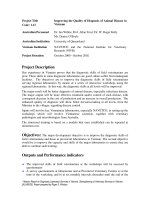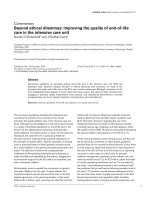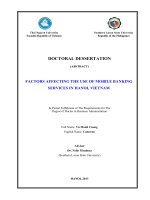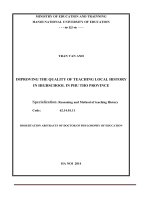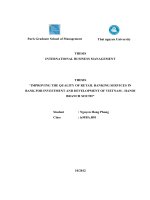Improving the quality of retail banking services in asia commercial joint stock bank,graduation thesis
Bạn đang xem bản rút gọn của tài liệu. Xem và tải ngay bản đầy đủ của tài liệu tại đây (799.31 KB, 46 trang )
Banking Academy
Graduation Thesis
STATE BANK OF VIETNAM
BANKING ACADEMY
Foreign Language Faculty
GRADUATION THESIS
IMPROVING THE QUALITY OF RETAIL BANKING SERVICES
IN ASIA COMMERCIAL JOINT-STOCK BANK
Student : Tran Thi Hong Nhung
Class
: ATCA – K12
Lecturer : Mrs. Can Thuy Lien (MA)
Ha Noi – June, 2013
ACKNOWLEDGEMENTS
Tran Thi Hong Nhung
Class: ATCA – K12
Banking Academy
Graduation Thesis
After a long time of hard work, my thesis would not have been completed
without the support of many people.
First of all, I would like to express my deepest gratitude to my supervisor Mrs. Can Thuy Lien who was abundantly helpful and offered me invaluable
suggestions and contribution. Moreover, her enthusiastic instructions and
corrections helped my graduation thesis be better.
In addition, I wish to say sincere thanks to all the lecturers of Banking
Academy in general and teachers of Foreign Language Faculty in detail for
conveying precious knowledge to me to become a well-educated student.
Another appreciation is given to managers and staff of Asia Commercial
Bank, Den Lu Transaction point who created me favorable conditions to fulfill
my internship period.
Last but not least, I am very thankful to my friends and my beloved family
members for their great support and understanding. It is their encouragement
during my research that give me a spiritual foundation and strength to complete
this task and make it successful.
Tran Thi Hong Nhung
Class: ATCA – K12
Banking Academy
Graduation Thesis
LIST OF TABLES AND FIGURES
Table 3.1: Rewards ACB received from 2006 to 2012 .......................................................... 11
Table 3.2: ACB’s retail fund mobilization in the period 2009 – 2012 ................................ 13
Table 3.3: ACB’s retail loans between 2009 and 2012. ......................................................... 14
Table 3.4: Number of cards issued of ACB in 2011, 2012 .................................................... 16
Figure 3.1: ACB’s retail fund mobilization in the period 2009 – 2012 ............................... 13
Figure 3.2: Structure of retail deposit by types of money in 2012 ....................................... 14
Figure 3.3: ACB’s retail loans in the period 2009 – 2012 ..................................................... 15
Figure 3.4: The number of branches and transaction points from 2009 to 2012 .............. 19
Tran Thi Hong Nhung
Class: ATCA – K12
Banking Academy
Graduation Thesis
LIST OF ABBREVIATIONS
ACB
: Asia Commercial Bank
ASEAN
: Association of South East Asian Nations
ATM
: Automatic Teller Machine
Eximbank
: Vietnam Export Import Bank
GPRS
: General Packet Radio Service
ID card
: Identity card
ISO
: International Standards Organization
IT
: Information technology
POS
: Point of sales
R&D
: Research and development
RBS
: Retail banking services
Sacombank
: Saigon Commercial Bank
SBV
: The State Bank of Vietnam
SMEs
: Small and medium enterprises
SWIFT
: Society for Worldwide Interbank Financial
Telecommunication
Techcombank
: Vietnam Technological and Commercial Bank
VIP
: Very important person
WTO
: World Trade Organization
Tran Thi Hong Nhung
Class: ATCA – K12
Banking Academy
Graduation Thesis
TABLE OF CONTENTS
CHAPTER 1: INTRODUCTION ............................................................................................ 1
1.1 Background ..........................................................................................................1
1.2 Objectives ............................................................................................................1
1.3 Research questions ..............................................................................................2
1.4 Scope .....................................................................................................................2
1.5 Methodology ........................................................................................................2
1.6 Disposition ............................................................................................................2
CHAPTER 2: THEORETICAL FRAMEWORK ............................................................... 3
2.1 Definition of retail banking services ..................................................................3
2.2 Characteristics of retail banking services ........................................................3
2.3 Roles of retail banking services .........................................................................4
2.3.1 To the economy ............................................................................................4
2.3.2 To banks ........................................................................................................4
2.3.3 To customers.................................................................................................4
2.4 Some main retail banking services ....................................................................4
2.4.1 Fund mobilizing services .............................................................................4
2.4.2 Lending services ...........................................................................................5
2.4.3 Card services ................................................................................................5
2.4.4 Settlement services .......................................................................................5
2.4.5 E-banking services .......................................................................................6
2.4.6 Other retail banking services ......................................................................7
2.5 The quality of retail banking services. ..............................................................7
2.5.1 Overview of the quality of RBS ..................................................................7
2.5.2 The importance of enhancing the quality of RBS .....................................7
CHAPTER 3: RETAIL BANKING SERIVES IN ASIA COMMERCIAL BANK ... 10
3.1 Introduction of ACB .........................................................................................10
3.1.1 Establishment .............................................................................................10
3.1.2 Business scope.............................................................................................10
3.1.3 Vision and Mission .....................................................................................11
3.1.4 Rewards ......................................................................................................11
3.2 Analysis of ACB's the retail banking activity over the period 2009 – 2012 12
3.2.1 ACB’s performance of some main RBS...................................................12
3.2.1.1 Fund mobilizing services ....................................................................12
3.2.1.2 Lending services ..................................................................................14
3.2.1.3 Card services .......................................................................................16
Tran Thi Hong Nhung
Class: ATCA – K12
Banking Academy
Graduation Thesis
3.2.1.4 Settlement services .............................................................................17
3.2.1.5 E-banking services ..............................................................................18
3.2.2 Distribution network .................................................................................18
3.2.3 Technology ..................................................................................................20
3.2.5 Customer care policies ...............................................................................21
3.2.6 Marketing activities ...................................................................................22
3.3 Evaluating the quality of ACB’s RBS ............................................................22
3.3.1 Comparing the quality of RBS in ACB with that of some other banks 22
3.3.2 Some ACB’s achievements in the retail services section ........................23
3.3.3 Some ACB’s limitations in the retail services section .............................24
3.3.4 Causes resulting in limitations ..................................................................25
CHAPTER 4: SOLUTIONS TO THE IMPROVEMENT OF THE QUALITY OF
RETAIL BANKING SERVICES IN ASIA COMMERCIAL BANK ........................... 28
4.1 Promoting research and development of RBS ...............................................28
4.1.1 Strengthening and improving existing retail services: ...........................28
4.1.3 Developing new RBS: ................................................................................28
4.2 Expanding the distribution network ...............................................................29
4.2.1 Developing traditional distribution channels ..........................................29
4.2.2 Developing modern distribution channels ...............................................30
4.2.3 Upgrading facilities and equipments........................................................30
4.3 Investing in technology development ..............................................................31
4.4 Enhancing the quality of human resources ....................................................32
4.4.1 Fulfilling the recruitment process ............................................................32
4.4.2 Raising the training quality ......................................................................32
4.4.3 Maintaining suitable reward policies .......................................................33
4.4.4. Concentrating on professional style of retail staff .................................33
4.5 Strengthening the customers care....................................................................33
4.6 Promoting Marketing activities .......................................................................34
4.7 Improving the quality of inspection of the service quality ............................35
4.8 Recommendations to the Government and the the State Bank. ...................36
4.8.1 Recommendations to the Government .....................................................36
4.8.2 Recommendations to the State Bank .......................................................36
CONCLUSION .......................................................................................................................... 39
REFERENCES
Tran Thi Hong Nhung
Class: ATCA – K12
Banking Academy
Graduation Thesis
CHAPTER 1: INTRODUCTION
1.1 Background
International integration has opened up many opportunities as well as challenges
for organizations providing banking services in Vietnam. They have to face with fierce
competition with foreign banks who have not only strong financial ability but also
experience in development of modern banking services.
Although Vietnam’s population is estimated to reach 89 million in 2012, the
citizens’ income and educational level is increasing, only 20% of them use banking
services. Thus, Vietnam is considered as a potential market for retail banking services.
Under the pressure of competition of bank services and the rapid development of
information technology, commercial banks are paying attention to modernization and
application of scientific advances in exploiting the retail market.
It is understandable that Asia Commercial Bank (ACB) is not excluded from this
indispensable trend. Therefore, the strategy of ACB will focus mainly on providing
diverse, professional and convenient retail products to suitable customers, with the aim
of building up a high quality, safe and economically efficient retail banking services
system. To meet the increasing need of using banking services of customers, and to
compete with other commercial banks, without doubt, ACB is expanding the network,
diversifying retail products, improving their quality of services and enhancing the
serving manner to customers to achieve the goal of being a top retail bank in Vietnam
and developing the retail banking services system which has the same level with that
of other banks in the area. In addition, the bank is boosting its competitiveness,
prestige and reputation gradually in international financial market.
For this above reality, the assessment of the quality of retail banking services in
ACB as well as proposing some measures to improve the quality services help the
bank gain the customers’ satisfaction. Therefore, I decided to choose and do research
entitled “Improving the quality of retail banking services in Asia Commercial Bank”.
1.2 Objectives
The thesis aims at evaluating the actual quality of retail banking services and
proposing some solutions to improve the quality of retail banking services in
Asia Commercial bank.
Tran Thi Hong Nhung
1
Class: ATCA – K12
Banking Academy
Graduation Thesis
1.3 Research questions
The discussed problem will answer the following questions:
What are RBS and their roles?
Why the quality of RBS should be enhanced?
How was the performance of RBS in ACB from 2009 to 2012?
What were achievements an limitations of the bank over that period?
What solutions should be proposed to promote the quality of RBS of the bank?
1.4 Scope
At present, commercial banks in general and ACB in detail offer a wide range of
retail banking services. However, due to limited time, the thesis will concentrate on
five main retail services provided by ACB. They are Fund mobilizing services,
Lending services, Card services, Settlement services and E-banking services.
1.5 Methodology
To find out the performance of retail services in ACB over the period 2009 –
2012 , the secondary data (such as financial reports, annual reports, introduction of the
bank and information from the Internet sources) was used. After that, factors affecting
the bank’s retail performance were analyzed and then, solutions for improvement will
be suggested.
1.6 Disposition
Chapter 1:
Introduction
Chapter 2:
Theoretical framework
Chapter 3:
Retail banking services in Asia Commercial Bank
Chapter 4: Solutions to improve the quality of retail banking services in Asia
Commercial Bank.
Tran Thi Hong Nhung
2
Class: ATCA – K12
Banking Academy
Graduation Thesis
CHAPTER 2: THEORETICAL FRAMEWORK
2.1 Definition of retail banking services
Depending on different points of view and approaches, there are now some
concepts of “Retail banking services” (RBS):
According to economists of The Asian Institute of technology (AIT), RBS are to
provide products and banking services for individuals, small and medium enterprises
(SMEs) through network of branches, telecommunications and modern technology.
As it stated by World Trade Organization (WTO), RBS are typical services of
banks where retail customers can come to branches or transaction points to carry out
transactions, such as depositing, checking accounts, mortgaging, borrowing money,
and other services.
In summary, retail banking services can be defined as follow: “Retail banking
services are banking services provided for personal customers, SMEs through network
of branches or telecommunications”.
2.2 Characteristics of retail banking services
a. Customers of RBS are individuals, households and SMEs.
b. RBS are diverse and the value of each transaction is not high, so the level of
risk is relatively low.
c. RBS require the building of many distribution channels to provide services for
customers on a large scale.
d. RBS base mainly on modern information technology and professional staff in
order to improve the quality of products and bring them to each customer.
e. RBS are simple and easy to be implemented because the main services are
deposits, payments, loans and card services.
f. The business development base primarily on the quality of services, so high
quality products will definitely be an important factor for boosting revenue and
attracting customers.
g. Average operating costs are quite high. Although the customers quantity is
considerable, they are widely dispersed which make the transactions not convenient.
Besides, banks’ investment in online trading is still costly.
Tran Thi Hong Nhung
3
Class: ATCA – K12
Banking Academy
Graduation Thesis
h. Because customer networks are national wide, the management and marketing
forms are diverse and complicated.
2.3 Roles of retail banking services
2.3.1 To the economy
RBS change a cash economy directly to a non-cash one, enhance the efficiency
of State management as well as reduce the social costs of payment. In addition, with
RBS, cash cycle process is enhanced and more effective, the potentiality of capital was
exploited to promote business, consumption and improve the people’s lives.
2.3.2 To banks
RBS take a part in diversifying of products, expanding the market, improving the
competitiveness, creating medium and long-term capital for banks, altering the income
structure of banks, minimizing risks and strengthening the national finance.
2.3.3 To customers
RBS bring convenience, safety and efficiency to customers in their payment
process and in using their own income.
Currently, RBS creates a stable income, risk diversification and a solid
foundation for banks. Therefore, commercial banks have initially considered RBS as
core activities in order to build up, consolidate and develop a good customer base;
afterwards, they can enlarge other banking activities. Commercial banks in Vietnam
have been improving the quality of RBS as an inevitable trend, consistent with the
common trend of banks in region and around the world.
2.4 Some main retail banking services
2.4.1 Fund mobilizing services
It is obvious that one of the most function of commercial banks is mobilizing
fund for lending loans and investments. They can raise capital from personal
customers and SMEs in the forms of term deposits, issuing valuable papers
(promissory notes, bank bonds…) and other forms of deposits. Although idle capital of
individual customers and SMEs is not much, banks can still mobilize a potential and
plentiful fund because of large number of customers.
Tran Thi Hong Nhung
4
Class: ATCA – K12
Banking Academy
Graduation Thesis
Nowadays, beside traditional deposit products, commercial banks have offered a
variety of savings products with flexible terms and interest rates to not only develop
their brand names but also meet the need of customers.
2.4.2 Lending services
Retail lending services offer individual customers and SMEs short, medium or
long term loans, including: overseas studying loans, real estate loans, stock trading
loans, consumer loans, overdraft and so on.
Loans for individuals and SMEs have accounted for an increasing proportion of
total debit balance of banks and they contribute to the banks’ higher revenue and
profit. However, these borrowers are relatively sensitive to interest rates, terms and
procedures, so banks need to consider their competitiveness in the market and
customers’ benefits.
2.4.3 Card services
Bank card is a personal financial and multifunctional product, issued by banks
and brings various advantages to users. Cards can be used to withdraw, deposit money,
make payment or transfer money. Today, there is a wide range of card types, but it can
be seen that, generally, two main kinds of cards are debit cards (domestic and
international) and credit cards.
Thus, card services play an important role in mobilizing funds, collecting service
fees and boosting the image of banks in public eyes. Card services associate with the
application of technology and co-operation among banks in exploiting the market.
2.4.4 Settlement services
Settlement service is considered as an activity bringing a great yield to banks,
and it includes current accounts, checks, money transferring, collection orders and
payment orders… Banks are on behalf of their customers to make payment for goods
and services through clearing system or through electronic payment system. Salary
payment through personal accounts, electricity, water and telephone bill payment are
services growing significantly and generating a great revenue for commercial banks.
In addition, remittance services have been increasing and expanding, and a lot of
commercial banks have cooperated and become agencies of international financial
institutions like Western Union and Money Gram.
Tran Thi Hong Nhung
5
Class: ATCA – K12
Banking Academy
Graduation Thesis
2.4.5 E-banking services
In the context of financial market and banking integration, foreign banks have
chances to take part in Vietnam’s market, which, without doubt, requires domestics
banks to seek for new and different services and products to strengthen their
competitiveness. Thus, the born of banking services using modern technology is
understandable.
Today, SMS Banking, e-banking and Mobile Banking services… become
popular choices of customers because they do not have to come directly to the banks
and save their time of transacting, such as: transferring, checking accounts, making
payment and borrowing.
The application of E-banking services in bank business is an advantage and also
a necessary factor determining success in the trend of developing RBS in the future.
There are some prevailing modern E-banking services as follow:
a. Call center: provide information, answer questions and complaints of
customers. Nowadays, most of banks have Call centers like ACB’s 247/247 center and
Eximbank’s 24/7 center.
b. Phone banking: is the service that customers can make phone calls to the
banks’ automatic answering telephone to know about bank services, interest rates,
exchange rates and information of personal accounts.
c. Mobile banking: with an internet – connected mobile phones (wifi, 3G or
GPRS), customers can easily conduct transactions, check the account balance, pay
electricity bills, internet fare and online transfer… These essential functions are easy
to use and help their busy life become easier.
d. Internet banking: is bank service that allows customers to conduct
transactions with banks through the internet. To access this service, the customer
would go to the bank’s website, and enter the online banking facility using the
customer number and password. Apart from banking tasks (paying third parties,
investment purchase or sale, funds transfer,…), users can perform some nontransactional tasks including viewing account balances, viewing recent transactions,
downloading periodic account statements and so on.
Tran Thi Hong Nhung
6
Class: ATCA – K12
Banking Academy
Graduation Thesis
2.4.6 Other retail banking services
Beside above services, banks also offer other convenient services, such as
valuable assets keeping, personal financial consulting, foreign currency or treasury
services…
2.5 The quality of retail banking services.
2.5.1 Overview of the quality of RBS
Undoubtedly, a bank’s performance is noticeably affected by the service quality
and it also become a marketing tool of competitors to promote the customers’
satisfaction and loyalty as well. Customers can only take the gauge of the services
after coming to the banks and using their offered products.
The quality of RBS includes:
a. Retail staff (from senior managers to junior staff): they need qualification,
communication skills, professional sales skills, enthusiasm, attentive attitude and
agileness…
b. Retail products: each product has its own characteristics and is designed to
meet the needs of customers.
c. Process: it should be fast, accurate, not too complicated and be supported by
modern devices.
d. Distribution channels: they should be convenient and easily accessible.
2.5.2 The importance of enhancing the quality of RBS
First, banking business is described as a sensitive and remarkably competitive
one because money is a special business object and a small variation in socioeconomic background can result in a great fluctuation of currency value and vice
versa. Furthermore, because products of retail banks are highly competitive
(diversified, easy to be imitated…), competition is a crucial matter of banks and it will
determine their survival in the market. Therefore, banks have no choice but to raise
their position by improving the service quality and bear in mind that “ higher service
quality a bank provide, more advantages they gain”
Moreover, banking services are presented to satisfy the customers’ requirements
and it is undeniable that if the quality of RBS is increasingly perfect, customers will
extend their loyalty, relationship with banks, and even they help banks to attract new
Tran Thi Hong Nhung
7
Class: ATCA – K12
Banking Academy
Graduation Thesis
clients by their recommendations. Along with that, at present, considerably more
banks are established, so customers will be more demanding, have comparison among
banks, assess them and make decisions on which banks they will deal with. Lifting the
quality of RBS up means assisting banks in retaining old clients, drawing new ones,
expanding their market share, diversifying risks, enhancing competitiveness and
stabilizing operations.
Especially, in the context of international economic integration, building a safe,
efficient and high quality system of RBS will permit commercial banks to enlarge their
market (even to a foreign one) and supply utility to all types of customers. By 2015,
Vietnam banks will strive for achieving a RBS system being on par with that of banks
in the area. This will definitely prove Vietnam’s position in the global economic
market.
Tran Thi Hong Nhung
8
Class: ATCA – K12
Banking Academy
Graduation Thesis
SUMMARY CHAPTER 2
In recent years, under the pressure of competition in banking system and the high
development of modern technology, commercial banks in Vietnam has begun to
promote modernization and applied technological advances in exploiting the retail
market. The banks are racing against each other on the quality of services,
development scale, capital resources, system networks, as well as technology to create
a necessary infrastructure for the development of retail services, meeting the
increasing demand of customers, facing the challenges of the international economic
integration proactively.
Chapter 2 of the thesis refers to a theoretical overview of RBS. Through
researching the related issues of the quality of RBS and the need to improve it, it is a
foundation for analyzing the actual situation of RBS and proposing solutions to
enhance RBS in Asia Commercial Joint-Stock bank (ACB) in next chapters.
Tran Thi Hong Nhung
9
Class: ATCA – K12
Banking Academy
Graduation Thesis
CHAPTER 3: RETAIL BANKING SERIVES
IN ASIA COMMERCIAL BANK
3.1 Introduction of ACB
3.1.1 Establishment
Asia Commercial Joint-Stock Bank (ACB) was established under the Business
License No. 0032/NH-GP dated 24 April 1993 by the State Bank of Vietnam and
Establishment Permit No. 533/GP-UB dated 13 May 1993 by the People’s Committee
of Ho Chi Minh City. ACB officially came into operations on 04 June 1993, so it was
established at the early stage of the country’s “Renovation - Doi moi” when the
economy started to transform from central mechanism to market one. Beginning with a
merely VND 20 billion (less than USD 3 million) charter capital and 27 staff, and
until 31 December 2012, these figures were 9,377 billion and 10,000 respectively.
Noticeably, ACB has extended the network up to total 345 branches and transaction
points national wide.
Headquarters: 442 Nguyen Thi Minh Khai, District 3, Ho Chi Minh city.
Website: www.acb.com.vn
3.1.2 Business scope
The main business activities of ACB are to:
a. Mobilize short, medium and long-term capital in the form of time deposits,
demand deposits and certificates of deposits and receive investment funds
b. Receive capital from domestic and overseas financial institutions
c. Grant short, medium, and long-term loans
d. Discount commercial paper, bonds and valuable documents
e. Invest in securities and companies
f. Provide settlement services to customers
g. Deal in foreign exchange and gold
h. Act as an agent and provide consultancy services for securities investment
i. Provide securities deposit services, corporate finance consultancy services,
underwriting services, asset management services, leasing and other banking services.
Tran Thi Hong Nhung
10
Class: ATCA – K12
Banking Academy
Graduation Thesis
3.1.3 Vision and Mission
ACB should take advantage of opportunities in the new stage of development of
Vietnam in order to further strengthen its position as a leading domestic financial
institution; to successfully accomplish its mission as the family bank; to become a
profitable investee company for investors and a bank dedicated to serving customers;
to offer products and services with leading quality; to be a good place for the staff to
develop their careers, a trustworthy partner in the financial community, and an
organization with noteworthy contribution towards the society.
3.1.4 Rewards
During 20 years of operation, ACB has always been in the group of large-scale
commercial banks and gained many achievements:
Table 3.1: Rewards ACB received from 2006 to 2012
Year
2006
2007
Prize
Rewarder
Third-Class Labor Medal
State President
Best Retail Bank in Vietnam 2005
The Asian Banker
Best Bank in Vietnam
Euromoney
Leadership Achievement Award for the
The Asian Banker
Financial Services Industry in Vietnam in 2006
2008
“Most Admired Enterprises of ASEAN” under
ASEAN Business Advisory
employment category
Council
Second-Class Labor Medal
State President
Best Bank in Vietnam
Euromoney
Best Bank in Vietnam
FinanceAsia, Asiamoney,
Global Finance, The
2009
Banker, Euromoney, and
The Asset
Tran Thi Hong Nhung
11
Class: ATCA – K12
Banking Academy
2010
Graduation Thesis
Best Bank in Vietnam
FinanceAsia, Global
Finance, Asiamoney, and
The Asset.
2011
Strongest Bank in Viet Nam
The Asian Banker
Best bank in Vietnam
Global finance, Asia
Money, Euromoney and
World Finance.
2012
Best bank in Vietnam
Euromoney
Top 10 annual report of the year
HoChiMinh Stock
Exchange
(Source: www.acb.com.vn)
Being early founded in Vietnam’s banking system, ACB has become one of the
largest commercial banks the country, the bank’s image and
prestige is widely
recognized by both development of banking quality and quantity.
With powerful and experienced managers and administrators in the bank
industry, along with professionally trained, young and enthusiastic employees, ACB is
fully capable of achieving the objectives set out in the strategy: becoming one of the
best retail bank in Vietnam.
3.2
Analysis of ACB's the retail banking activity over the period 2009 – 2012
3.2.1 ACB’s performance of some main RBS
3.2.1.1 Fund mobilizing services
Following closely market changes, ACB launched deposit rates that are
competitive, suitable and ensure customers’ benefits. In addition, ACB provided many
deposit products to satisfy the increasingly diverse needs of customers such as
“flexible saving account”, “Loc Bao Toan saving and insurance account” and carried
out many utilities like transferring the principal and interest automatically from time
deposit account to non-term one and holding attractive promotion programs (namely
bonus interest or lucky draw…) Thus, it is no doubt that ACB always put the
depositors’ priority above all and created lots of advantages for them.
Tran Thi Hong Nhung
12
Class: ATCA – K12
Banking Academy
Graduation Thesis
With the continuous improvement of service quality, staff’s manner and process
of services, deposits of individuals had positive changes, contributed to stabilizing the
fund and attracted new idle capital in the society.
Until 31 December, 2012, deposits of private customers reached 110,452 billion
VND, increased by approximately 39,000 billion (equal 35%) compared to 2009.
Table 3.2: ACB’s retail fund mobilization in the period 2009 – 2012
Amount
(billion VND)
2009
2010
2011
2012
71,196
89,885
102,498
110,452
81.9
84.1
72.1
88.2
Proportion in
total fund
mobilized (%)
(Sources: ACB’s annual report from 2009 to 2012)
Figure 3.1: ACB’s retail fund mobilization in the period 2009 – 2012
120,000
100,000
80,000
60,000
40,000
20,000
0
2009
2010
2011
2012
(Sources: ACB’s annual report from 2009 to 2012)
Tran Thi Hong Nhung
13
Class: ATCA – K12
Banking Academy
Graduation Thesis
Figure 3.2: Structure of retail deposit by types of money in 2012
18%
VND
82%
Foreign currencies
and gold
( Sources: ACB’s annual report from 2009 to 2012)
Generally speaking, ACB’s quality of fund mobilizing services was fully
expressed through promotion programs, competitive and flexible deposit interest rates,
good customer care policies, simple and time saving transaction process which all
create a good mood for customers.
3.2.1.2 Lending services
ACB has offered a great number of loan products with reasonable time, interest
rates to finance the customers’ capital needs.
Table 3.3: ACB’s retail loans between 2009 and 2012.
Amount
(billion VND)
2009
2010
2011
2012
23,005
32,584
35,846
44,348
36.9
37.4
34.9
43.1
Proportion in
total debit
balance (%)
(Sources: ACB’s annual report from 2009 to 2012)
Tran Thi Hong Nhung
14
Class: ATCA – K12
Banking Academy
Graduation Thesis
The proportion of retail loans in the total lending revenue over the period 2009 –
2012 increased dramatically, i.e. from 35% to nearly 43%. By 31 December 2012,
individual debit balance reached 44,348 billion VND, rose by 8,502 billion VND
(equal 23.7%) in comparison with 2011.
Figure 3.3: ACB’s retail loans in the period 2009 – 2012
44,338
45,000
35,000
35,846
32,584
40,000
23,005
30,000
25,000
20,000
15,000
10,000
5,000
0
2009
2010
2011
2012
(Sources: ACB’s annual report from 2009 to 2012)
Retail loans in ACB achieved a positive growth and became one of the most
important source of its income. To satisfy the growing demand of customers, ACB has
researched and launched diverse lending products, namely: loans for house
construction and renovation, overseas study loans, automobile loan, T-day securities
loans, and loans for developing agricultural economy… Beside secured loans, ACB
also supplied unsecured ones like consumption loans for company’s staff and overdraft
facility. With many advantages: ACB’s fame, enthusiastic attitude of customer service,
simple procedure, competitive interest rates and fees, ACB has proved its position in
the credit market.
Overall, thanks for a strict retail credit management, credit quality of ACB has been
under control and bad debt ratios has not exceeded the regulated level of the State Bank.
Tran Thi Hong Nhung
15
Class: ATCA – K12
Banking Academy
Graduation Thesis
3.2.1.3 Card services
With experience of over 10 years providing card payment services, ACB has
served more than 4,000 business places throughout cities (or provinces) around
Vietnam. Customers using card payment services are in category of multiple
businesses such as hotels, restaurants, air-ticket agencies, supermarkets, hospitals, art
galleries, jewelry and gemstones shops at almost commercial cities and tourist areas.
Specifically, ACB card center has cooperated with many trading partners to issue
domestic cards named: ACB - Saigon Co-op (CO-opmart supermarket chain), ACB Saigontourist (Saigontourist system), ACB - Mai Linh (Mai Linh taxi), ACB - Phuoc
Loc Tho (Mien Dong supermarket chain, Citimart, Maximark). Therefore, ACB’s card
holders can gain several payment advantages whenever the partners launch promotion
programs.
At present, ACB’s card payment system accepts the payment of 3 different types
of international cards: Visa, MasterCard, JCB and other credit cards, debit cards of
ACB. With this service, customers definitely feel secured to pay their bills without
cash usage.
The number of cards issued in 2012 was 205,427 increased by approximately
45,000 cards (or 28%) compared to 2011.
Table 3.4: Number of cards issued of ACB in 2011, 2012
2011
2012
International cards
86,664
110,930
Domestic cards
73,825
94,497
Total
160,849
205,427
(Sources: ACB’s card department)
To better card service quality, since mid 2010, ACB has applied EMV chip
technology to all ACB international cards so as to ensure safety for users and limit risk
during their dealing. Simultaneously, customers’ complaints and transaction problems
have been always tackled in the shortest time.
Tran Thi Hong Nhung
16
Class: ATCA – K12
Banking Academy
Graduation Thesis
3.2.1.4 Settlement services
ACB has offered a wide range of remittance activities as follow:
a. Outward remittance to domestic banks: The network of ACB are helping
customers transfer money quickly, conveniently and safety at any place in Vietnam.
The successful application of information technology TCBS (The Complete Banking
Solution) enables online transactions in the banking system. Customers can send
money to a place, get money elsewhere or transfer money to bank accounts in the
system which is made immediately.
b. Outward remittance to overseas: a service helps customers transfer money to
any overseas bank quickly and safely via SWIFT. Remittance service is conducted for
legal purposes complied with prevailing regulations on foreign currency management
of the State Bank of Vietnam. Customers can deposit foreign currency in the bank for
remittance or do bank transfer from their accounts in many different foreign
currencies.
c. Inward remittance from domestic banks: ACB offers this service to help
customer get the money transferred from domestic banks. ACB’s nationwide network
system helps customers to receive money at any branches of ACB quickly and safely.
If the customer receives the cash transferred by ID card, ACB will notify the customer
by the correspondence or telephone. Whether customers have accounts or do not have
accounts in the bank, they can receive the transferred money and they do not need to
report its’ sources.
d. Inward remittance from overseas: ACB provides this service for customers to
help them receive cash from foreign countries. ACB’s network system covers across
the country that helps customers to receive the cash transferred at any branches of
ACB quickly and safely. If the cash transfer is not done via account (cash transfer is
done by ID card), ACB will notify customer in the earliest time through
correspondence or telephone. Customers can receive the foreign currency (USD, EUR)
or resell them to ACB in order to get VND. For the transferred foreign currency which
is not USD or EUR, if the customer does not sell the foreign currency to get VND,
they can request to convert the transferred foreign cash into USD or EUR.
Tran Thi Hong Nhung
17
Class: ATCA – K12
Banking Academy
Graduation Thesis
In order to enhance utility for customers, ACB has joined the network of Western
Union that enables customers to transfer (or receive) money to (or from) many
countries over the world within only 10 minutes.
In addition, ACB also provides Electricity Bill payment service to bring a fast,
safe and convenient settlement to customers through their current accounts. Turning to
payment service for real estate trading, it is beneficial to both buyers and sellers. The
buyers will not be anxious if they pay money to seller when the procedure is not
completed. For sellers, they will be guaranteed because of buyer’s payment ability.
3.2.1.5 E-banking services
Banks’ customers nowadays has obviously an increasing demand for banking
services with high technology. Thus, ACB has constantly improved and developed ebanking services which is called ACB Online. ACB Online allows clients to carry out
transactions with the bank quickly, whenever and wherever. These retail services are
simple, safe, time saving and convenient when customers do not need to come directly
to the branches or transaction points. ACB Online includes Internet service, SMS
service, Phone service and Mobile service.
a. Internet service: permits customers who have current account transact with the
bank any time they have internet-connected laptops or desk computers.
b. Mobile service: helps customers deal with the bank through a mobile phone or
a tablet which is connected to wifi, 3G or GPRS.
c. SMS service: customers who have current account can transact with the bank
by texting a form before sending it to 997.
d. Phone service: is a automatic center about information of banking products.
With a personal account, customers can press the button to be clear more about the
wanted services.
Besides, ACB also offers Bill payment services to help customers settle their
electricity bill or phone bill of Mobiphone and Viettel.
3.2.2 Distribution network
Along with the product diversification and technology enhancement, ACB has
continuously expanded the network. The increase in the number of branches and
transaction points is a basic foundation for retail products development.
Tran Thi Hong Nhung
18
Class: ATCA – K12
Banking Academy
Graduation Thesis
Figure 3.4: The number of branches and transaction points from 2009 to 2012
326
350
300
236
345
281
250
200
150
100
50
0
2009
2010
2011
2012
(Sources: ACB’s annual reports from 2009 to 2012)
ACB maintains the wide range of correspondent bank networks overseas, with more
than 1,000 banking relationship worldwide, comprising many well-known banks in the
world such as Citibank, Deutsche Bank, Standard Chartered Bank, JP Morgan Chase
and Wachovia.
Overall, ACB’s network allocation is quite favorable and relatively national wide to
serve retail customers.
When dealing with the banks, customers can evaluate their capacity, scale and
profession by looking at their equipment and design. Because bank is a service sector,
the first impression is really important and it decides whether customers choose the
bank to deal with or not. Therefore, ACB has its own building model which helps
customers recognize the image of ACB immediately, the interior and exterior design
are ensured to be nice, modern and eye-catching. However, it is the fact that 85% of
the business premises are leased from the people’s houses and they are usually small
buildings, the parking place and advertising posters are limited.
ATM system has been extended over the past few years and until 2012, there
were nearly
500 ATMs and about 13,000 POS in Vietnam. The successful co-
operation with International payment organization (Visa, Master) and domestic system
(Banknet, Smartlink) has raised the efficiency of ATM remarkably, reflected through
growing number of transactions and revenue.
Tran Thi Hong Nhung
19
Class: ATCA – K12

